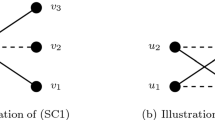Abstract
We consider the complexity of recognizing k-clique-extendible graphs (k-C-E graphs) introduced by Spinrad (Efficient Graph Representations, AMS 2003), which are generalizations of comparability graphs. A graph is k-clique-extendible if there is an ordering of the vertices such that whenever two overlapping k-cliques A and B have \(k-1\) common vertices, and these common vertices appear between the two vertices \(a,b\in (A{\setminus } B)\cup (B{\setminus } A)\) in the ordering, there is an edge between a and b, implying that \(A\cup B\) is a \((k+1)\)-clique. Such an ordering is said to be a k-C-E ordering. These graphs arise in applications related to modelling preference relations. Recently, it has been shown that a maximum clique in such a graph can be found in \(n^{O(k)}\) time [Hamburger et al. 2017] when the ordering is given. When k is 2, such graphs are precisely the well-known class of comparability graphs and when k is 3 they are called triangle-extendible graphs. It has been shown that triangle-extendible graphs appear as induced subgraphs of visibility graphs of simple polygons, and the complexity of recognizing them has been mentioned as an open problem in the literature. While comparability graphs (i.e. 2-C-E graphs) can be recognized in polynomial time, we show that recognizing k-C-E graphs is NP-hard for any fixed \(k \ge 3\) and co-NP-hard when k is part of the input. While our NP-hardness reduction for \(k \ge 4\) is from the betweenness problem, for \(k=3\), our reduction is an intricate one from the 3-colouring problem. We also show that the problems of determining whether a given ordering of the vertices of a graph is a k-C-E ordering, and that of finding a maximum clique in a k-C-E graph, given a k-C-E ordering, are hard for the parameterized complexity classes co-W[1] and W[1] respectively, when parameterized by k. However we show that the former is fixed-parameter tractable when parameterized by the treewidth of the graph. We also show that the dual parameterizations of all the problems that we study are fixed parameter tractable.




Similar content being viewed by others
Notes
Unlike in Theorem 7, here we only need to find just a clique on \((n-k)\) vertices, for which faster algorithms exist, but as the runtime for the other case dominates the overall runtime, a \(2^kn^{O(1)}\) algorithm suffices.
References
Bodlaender, H.L., Drange, P.G., Dregi, M.S., Fomin, F.V., Lokshtanov, D., Pilipczuk, M.: A \(c^kn\) 5-approximation algorithm for treewidth. SIAM J. Comput. 45(2), 317–378 (2016)
Brandstädt, A., Le, V.B., Spinrad, J.P.: Graph Classes: A Survey. Monographs on discrete mathematics and applications. Soc Indust Appl Mathemat (1999)
Cygan, M., Fomin, F.V., Kowalik, Ł, Lokshtanov, D., Marx, D., Pilipczuk, M., Pilipczuk, M., Saurabh, S.: Parameterized Algorithms, vol. 3. Springer, Berlin (2015)
Francis, M., Neogi, R., Raman, V.: Recognizing \(k\)-clique extendible orderings. In: Isolde A., Haiko M.(eds), Graph-Theoretic Concepts in Computer Science, volume 12301 of Lecture Notes in Computer Science, pages 274–285, Cham, (2020). Springer International Publishing
Golumbic, C.: Martin: Algorithmic Graph Theory and Perfect Graphs, vol. 57. Elsevier, Amsterdam (2004)
Hamburger, P., McConnell, R.M., Pór, A., Spinrad, J.P., Xu, Z.: Double threshold digraphs. In: Potapov, I., Spirakis, P., and Worrell, J. (eds) 43rd International Symposium on Mathematical Foundations of Computer Science (MFCS 2018), volume 117 of Leibniz International Proceedings in Informatics (LIPIcs), pages 69:1–69:12. Schloss Dagstuhl–Leibniz-Zentrum fuer Informatik, (2018)
Impagliazzo, R., Paturi, R., Zane, F.: Which problems have strongly exponential complexity? J. Comput. Syst. Sci. 63(4), 512–530 (2001)
Lokshtanov, D., Marx, D., Saurabh, S.: Lower bounds based on the exponential time hypothesis. Bulletin of EATCS 3(105), 41–71 (2013)
Mahajan, M., Raman, V., Sikdar, S.: Parameterizing above or below guaranteed values. J. Comput. Syst. Sci. 75(2), 137–153 (2009)
McConnell, R.M., Spinrad, J.P.: Linear-time transitive orientation. In: Saks, M. E. (eds) Proceedings of the eighth annual ACM-SIAM symposium on discrete algorithms, pp 19–25. Society for Industrial and Applied Mathematics (1997)
Möhring, R.H.: Algorithmic aspects of comparability graphs and interval graphs. In: Rival, I. (eds) Graphs and Order, pp. 41–101. Springer (1985)
Opatrny, J.: Total ordering problem. SIAM J. Comput. 8(1), 111–114 (1979)
Robertson, N., Seymour, P.D.: Graph minors. II. Algorithmic aspects of tree-width. J. Algo. 7, 309–322 (1986)
Spinrad, J.P.: Efficient Graph Representations. American Mathematical Society, Providence (2003)
West, D.B.: Introduction to Graph Theory, 2nd edn. Prentice Hall, New Jersey (2000)
Author information
Authors and Affiliations
Corresponding author
Additional information
Publisher's Note
Springer Nature remains neutral with regard to jurisdictional claims in published maps and institutional affiliations.
An extended abstract of this work appeared in the proceedings of the conference WG 2020 [4].
Rights and permissions
About this article
Cite this article
Francis, M., Neogi, R. & Raman, V. Recognizing k-Clique Extendible Orderings. Algorithmica 83, 3338–3362 (2021). https://doi.org/10.1007/s00453-021-00857-0
Received:
Accepted:
Published:
Issue Date:
DOI: https://doi.org/10.1007/s00453-021-00857-0




